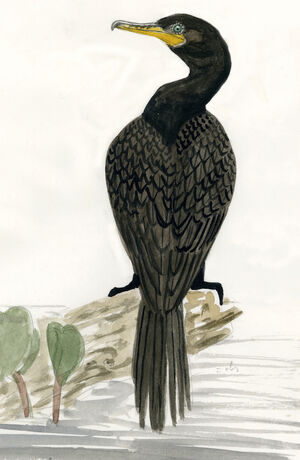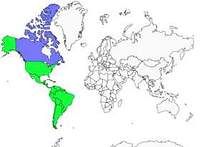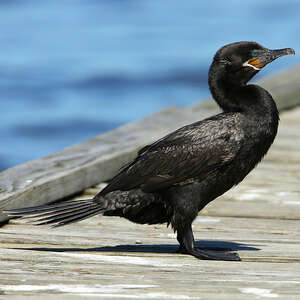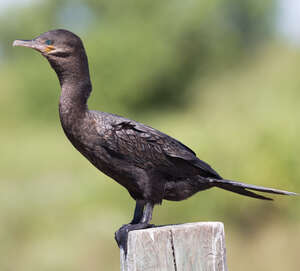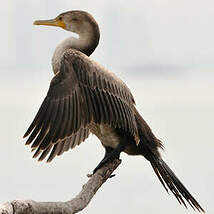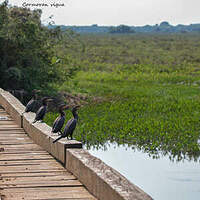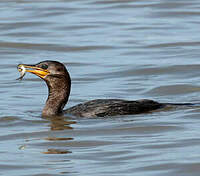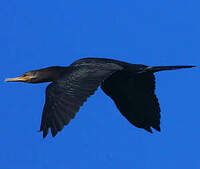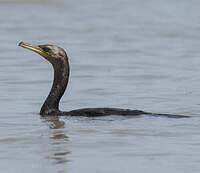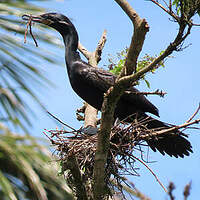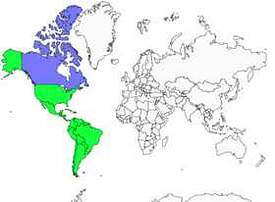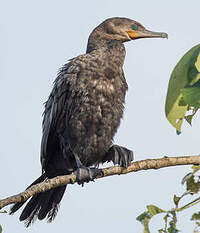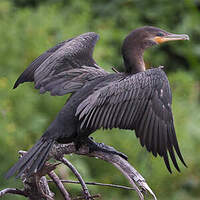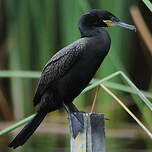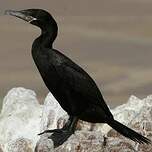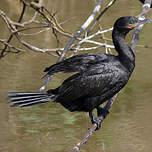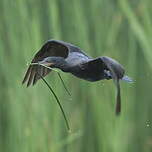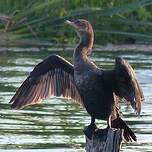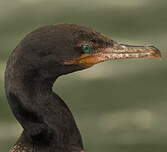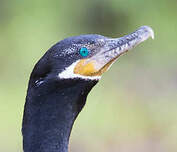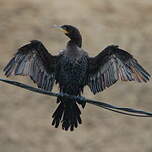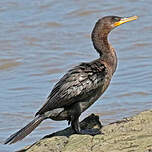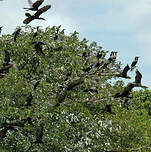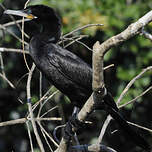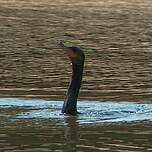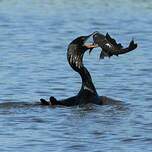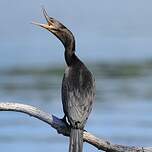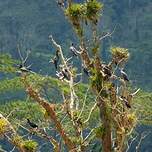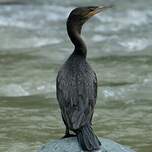Neotropic Cormorant
Nannopterum brasilianum - Cormoran vigua
Identification
The Neotropic Cormorant is the most widely dispersed cormorant in South America and the only one found far away from coasts in the interior of the continent. It measures around 60-70 cm in length, has a wingspan of 1 m, and weighs between 1.2-1.4 kg. There is no sexual dimorphism. From far away, the adult appears entirely black, but under proper lighting, its back shows bronze-green tones. It has a relatively long neck and a rather small head. Its eyes are emerald green. The beak is long and thin and ends with a hooked nail; it is gray-black with the base of the lower mandible being yellow. During the reproduction period, white feathers form a V at the base of the beak and white filoplumes appear behind the eye and in the ear region. The palmate feet are black. The juveniles are brown with the throat being lighter. They acquire the black plumage of adults around the age of two.
It looks very similar to the Great Cormorant (Phalacrocorax auritus) but their distribution areas only marginally overlap in the south of the United States and in the north of Mexico. The Neotropic Cormorant is smaller. The yellow at the base of its beak is less extensive and of a different shape; pointing back, giving the white V described before.
Subspecific information 2 subspecies
- Nannopterum brasilianum brasilianum (Costa Rica to Tierra del Fuego)
- Nannopterum brasilianum mexicanum ()
Foreign names
- Cormoran vigua,
- Cormorán biguá,
- biguá-preto,
- Humboldtscharbe,
- brazil kárókatona,
- Bigua-aalscholver,
- Cormorano neotropicale,
- amazonskarv,
- Flodskarv,
- kormorán olivový,
- kormorán neotropický,
- Olivenskarv,
- oliivimerimetso,
- corb marí neotropical,
- kormoran oliwkowy,
- garastes ūdenis,
- Бигуанский баклан,
- ナンベイヒメウ,
- 美洲鸬鹚,
- amazonskarv,
- 斑翅鸕鷀,
Voice song and call
Habitat
The Neotropic Cormorant lives in all terrestrial aquatic environments but prefers those with a minimum of depth: rivers, lakes, lagoons, estuaries, mangroves, artificial dams, including at high altitudes (up to 4500 metres in the Andes). It can also be found on rocky and sandy shorelines. It never strays far out to sea.
Behaviour character trait
It is a gregarious bird, a very good swimmer and diver. It spends most of its time in close proximity to bodies of water. It rarely moves on land, where it is clumsy. It swims with its body half submerged. It fills its feathers with water to increase its weight and facilitate the dive. When it leaves the water, it dries itself by perching on rocks or trunks, with its wings open and tail spread out. It is active during the day and sleeps in trees, sometimes in the company of herons or egrets.
Flight
Dietfeeding habits
The Neotropic Cormorant mainly feeds on fish and crustaceans. An excellent diver, it chases its prey underwater by propelling itself with its webbed feet. It can stay underwater for up to one minute. The average duration of dives is from 15 to 40 seconds depending on the abundance of prey. It also eats amphibians and aquatic insects.
Reproduction nesting
Neotropic Cormorants are monogamous. They nest in colonies that can reach several hundred couples. The male chooses the site and brings the construction material (branches for the exterior, twigs and algae for the interior) and the female builds the nest. The nests can be rehabilitated from one year to the next. The female lays 3 or 4 eggs with a few days interval. Incubation takes an average of 24 days and the chicks hatch over several days. Both parents feed the chicks for almost 3 months.
Geographic range
Threats - protection
Sources of information
- IOC World Bird List (v15.1), Gill, F and D Donsker (Eds). 2025-12-07.
- A Field Guide to the Birds of Brazil, Ber Van Perlo
- Handbook of the Birds of the World Vol 16, Josep del Hoyo, Andrew Elliott, David Christie
- Birds of the World, The Cornell Lab of Ornithology
- Wiki Aves,
Other sources of interest
 Specification sheet created on
30/07/2023 by Dietmar Petrausch
Specification sheet created on
30/07/2023 by Dietmar PetrauschTranslation by AI Oiseaux.net
© 1996-2025 Oiseaux.net
- Accipitriformes
- Aegotheliformes
- Anseriformes
- Apodiformes
- Apterygiformes
- Bucerotiformes
- Caprimulgiformes
- Cariamiformes
- Casuariiformes
- Charadriiformes
- Ciconiiformes
- Coliiformes
- Columbiformes
- Coraciiformes
- Cuculiformes
- Eurypygiformes
- Falconiformes
- Galliformes
- Gaviiformes
- Gruiformes
- Leptosomiformes
- Mesitornithiformes
- Musophagiformes
- Nyctibiiformes
- Opisthocomiformes
- Otidiformes
- Passeriformes
- Pelecaniformes
- Phaethontiformes
- Phoenicopteriformes
- Piciformes
- Podargiformes
- Podicipediformes
- Procellariiformes
- Psittaciformes
- Pterocliformes
- Rheiformes
- Sphenisciformes
- Steatornithiformes
- Strigiformes
- Struthioniformes
- Suliformes
- Tinamiformes
- Trogoniformes

